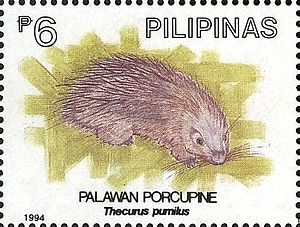Philippines porcupine
| Philippines porcupine | ||||||||||||
|---|---|---|---|---|---|---|---|---|---|---|---|---|

Philippines porcupine on a Filipino postage stamp |
||||||||||||
| Systematics | ||||||||||||
|
||||||||||||
| Scientific name | ||||||||||||
| Hystrix pumila | ||||||||||||
| Günther , 1879 |
The Philippines porcupine ( Hystrix pumila ) is a species of porcupine from the genus of real porcupines ( Hystrix ). It is endemic to the Philippine island of Palawan, as well as some neighboring islands.
features
The Philippines porcupine reaches a head and trunk length of 45.0 to 66.5 centimeters and the tail length is 6.4 to 19.0 centimeters, it reaches a weight of 3.8 to 5.4 kilograms. The hind foot becomes about 70 millimeters long, the ear length is about 30 millimeters. Like all real porcupines it is very large for a rodent, but the smallest species within the genus Hystrix . The spines and bristles as well as the tail rattle are not very pronounced compared to the other species and there are comparatively few spines on the back. A spiked and bristle comb on the head is not formed. The longest spines have a diameter of 4 to 5 millimeters and are uniformly black without the white tips typical of related species. The tail is short, it has a tail tassel made of spines transformed into a rattle. These hollow tubes are 10 to 11 millimeters long.
The Philippine porcupine differs from the Borneo porcupine ( Hystrix crassispinis ) and the Sumatran porcupine ( Hystrix sumatrae ) mainly in the lack of white porcupine tips.
distribution
The Philippines porcupine is endemic to the Philippine island of Palawan and the neighboring islands of Busuanga and Balabac .
Way of life
Very little information is available about the way of life of the Philippines porcupine. It occurs mainly in undisturbed primary and secondary forest areas in the lowlands, but also penetrates into adjacent meadows, bushes and agricultural areas. Like other porcupines, it is likely primarily herbivorous and lives in underground burrows. There is no information about reproduction and behavior.
Systematics
The Philippines porcupine is classified as a separate species within the genus of the real porcupines ( Hystrix ), which consists of eight species in Asia and Africa. The first scientific description comes from Albert Günther from 1879. He gave Puerto Princesa on Palawan as the place of origin . Within the genus, the species is placed in the subgenus Thecurus , which is occasionally also considered a genus of its own.
Apart from the nominate form, no subspecies are distinguished within the species .
Status, threat and protection
The Philippines porcupine is classified as threatened ("vulnerable") by the International Union for Conservation of Nature and Natural Resources (IUCN). This is justified by the sharp decline in stocks by more than 30% in the last few decades due to the loss of habitat due to logging and the removal for the national pet market and as a source of meat. For the Tagbanuwa living on Palawan , the species is of great importance and represents the most important hunting prey. They are excavated by them from their underground burrows.
supporting documents
- ^ A b A. Günther: Description of a new Species of Porcupine from the Philippine Islands. In: The Annals and Magazine of Natural History , 5th series, Vol. 4, pp. 106-107, 1879. (digitized version)
- ↑ a b c d e f E.L. Barthelmess: Philippine Porcupine - Hystrix pumila. In: Don E. Wilson, TE Lacher, Jr., Russell A. Mittermeier (editors): Handbook of the Mammals of the World: Lagomorphs and Rodents 1. (HMW, Volume 6), Lynx Edicions, Barcelona 2016; P. 325. ISBN 978-84-941892-3-4 .
- ↑ a b c d Hystrix pumila in the IUCN Red List of Threatened Species 2017.2. Submitted by: L. Heaney, D. Balete, G. Rosell-Ambal, B. Tabaranza, P. Ong, P. Widmann, 2008. Retrieved September 14, 2016.
- ↑ a b c Hystrix (Thecurus) pumila . In: Don E. Wilson , DeeAnn M. Reeder (Eds.): Mammal Species of the World. A taxonomic and geographic Reference. 2 volumes. 3. Edition. Johns Hopkins University Press, Baltimore MD 2005, ISBN 0-8018-8221-4 .
literature
- EL Barthelmess: Philippine Porcupine - Hystrix pumila. In: Don E. Wilson, TE Lacher, Jr., Russell A. Mittermeier (editors): Handbook of the Mammals of the World: Lagomorphs and Rodents 1. (HMW, Volume 6), Lynx Edicions, Barcelona 2016; P. 325. ISBN 978-84-941892-3-4 .
Web links
- Hystrix pumila inthe IUCN Red List of Threatened Species 2017.2. Submitted by: L. Heaney, D. Balete, G. Rosell-Ambal, B. Tabaranza, P. Ong, P. Widmann, 2008. Retrieved September 14, 2016.
